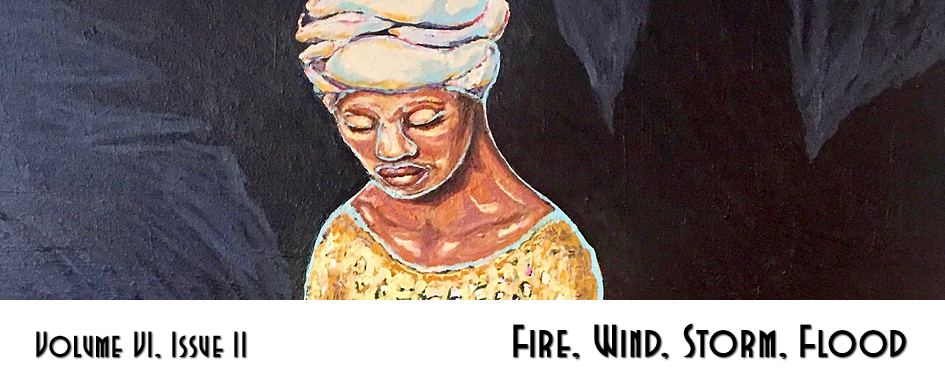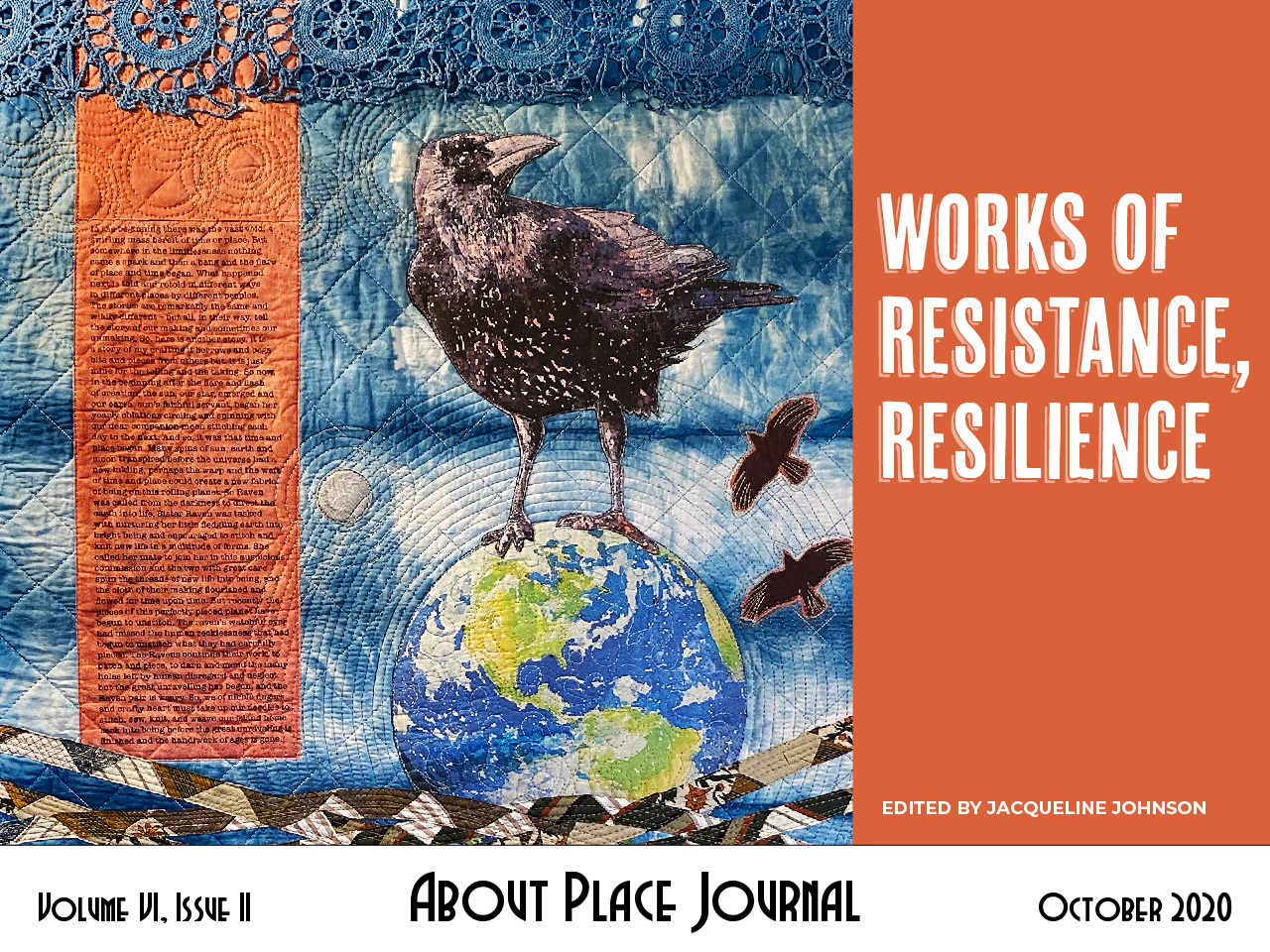Preface by Alison Adelle Hedge Coke. Edited by Linda Russo and Marthe Reed. (Wesleyan University Press, 2019). 129 pp. ISBN: 978-0-8195-7846-4.
In her preface to Counter-Desceration, Allison Adelle Hedge Coke dates the Anthropocene Era to the European invasion of the Western Hemisphere and the huge methane burst that must have accompanied the desecration that was the Doctrine of Discovery. She describes the project of this glossary as striving to “locate the lingual succinctness” that will “keep this world whole and inhabitable beyond what damage has already diminished its complete vitality.” This book, she concludes, offers us the “fortitude and wisdom to secure what means we might to continue to cherish and to equip us to protect our planet.”
New eras tend to call forth glossaries, maps of agreements on which to place major questions and concepts with which to begin working out answers. Glossaries can also aim to encourage a new everyday language. This kind of glossary sticks when it emerges from what already exists but is entirely new, or new in a way that can’t be described in old terms. Counter-Desecration is such a project. Composed of alphabetical entries accompanied by short explications and mini-essays that remind me of Friedrich Schlegel’s Athenaeum Fragments. One enters a collective mind, severally imagining a changed world. More, this glossary imaginatively reaches for concepts and habits we may yet live into. It is a project of radical and compassionate hope. The contributors are poets, environmentalists, theorists, fiction writers, activists. They are settlers of conscience, indigenous, multi-refuge-seeking immigrants, black, brown, queer, transgender, cisgender, and working class. In their work and in their persons they represent the social and historical intersections at which the future is being embodied in response to the amplitude of damage experienced by these communities. The contributors are the sort of people one could trust to envision an archeo-futural relation to the planet. The terms they offer or rewrite or invent prompt meditation on our involvement in enlivening or necrotic processes at work in our world. They also implore us to engage in the outward and reciprocal project of changing our way of life (all of it). A reader finds in these entries the company of other minds as interested in the reader’s well-being as that of the ecosystems that support us.
What a lexicon desires, however, is to be used. And for that to happen, the community using these words must expand, and with this language confront the extractive, exploitive, desecrated world we inhabit. It’s hard to tell whether this project also imagines a politics, or hopes to circumvent them. This might be the language of an ecologically and socially just politics, and it might be more fundamental than that: the poetics to render living as we do an historic curiosity. In late 2019, the world under Covid-19 was unimaginable, but here we are — all presented with a world-changing problem and immediate pressures to reimagine how we organize our whole social and economic scheme. We’re learning the language and the prediction trees of epidemiology. We might be able to learn the language of re-sacration, of reintroducing our world to Earth.
The trouble with so much language in the age of social media is its fungible and ersatz quality. It’s easier than ever for the corporate, consumer, and state apparati to appropriate and eviscerate the language that would resist or move beyond them. Some hashtags come to stand for a stage in a justice movement, #MeToo for instance, and some live on only in the internet archive such as #YesAllWomen and #BringBackOurGirls. The word “cool” has long been so completely co-opted that its original slang context would surprise many. The word “sustainable” evolved quickly from a specifically environmental context to mean just about any kind of longish term best practice or efficient organization. That’s a difficult context for a project that proposes a language. Fortunately, either by dint of mind or long consideration, many terms offered in Counter-Desecration clearly resist this kind of appropriation. Betweenness, The Great Plaints, ovulept, phytisentience, ruins, temenos, vivetocracy, washland. Some are infelicitous to capitalist misdirection, some are unremarkable and the more subversive for it, and some come directly from communities disrupted by the forces that extract resources, labor, vitality. The way these terms swerve and vere, or portmanteau elements from several fields, they have the virtue of being awkward enough not to become merely fashionable.
Even as pollution levels drop noticeably under stay-home advisories for Covid-19, the possibility of a livable Anthropocene is far from given. In the US, a pro-business administration rolls back automobile mileage standards, air and water protections, preservation of public lands sacred to indigenous people. The Abenaki word “akiw8gon,” embeds the reader in a canny (rather than innocent) embodied sense of their orientation to the world as land and spirit. It’s a huge gift, this word for this connection. The modernized settler languages don’t have a word for this living-in-belonging or enchantment-into-the-real. Coming from an indegenous author, this word is a trust and a charge.
Readers will find many personal resonances here too. For the reviewer, two terms describe my own oscillating bodily and emotional states. An inhabitant is “an organism that cultivates and deploys knowledge of biotic community, contributes to sustaining life processes, seeks meaningful material relation beyond ecologically irrelevant political boundaries, seeks familiarity with plants and animals, geographical specificies, and so on” — one who really lives into the place where they are. The great oaks in my backyard are slowly choking on a parasitic mycelium that competes with the beneficial ones. It’s too wet in Mid-Atlanic now. The English Ivy (invasive, cloying, everywhere) prevents evaporation that balances the soil and keeps the roots strong. I chose this place for these trees, their massive presence, their shelter, and now they need me to become something of an arborist and forester. The ground needs aerating, and both ivy and amarillia have more endurance that I have years left to me, but go they must.
To its credit, this glossary acknowledges the damage and grief of impending ecological collapses. An inhabitant may have an optimistic relation to their place, but it is laced through with tragedy. All that ivy covers this tree-shaded suburb because it is a low-maintenance, wet and drought resistant ground cover. In England, both goats and sheep used to forage on it. Alas, these suburbs are light on those bovidae. “Repoise” describes this implication and burden: “an inner-eruptive-tense (not future, not present, not past) emerging from repose. To repoise is to not deny or avoid the poison of an all-consuming-and-deadening event, be it a personal, local, political, or global poison,” and then to fully alchemize it. To find in the poison’s “numbness an i hiding inside the deadness of repose, an i that is a tincture made of the poison, … born of the disruption, brought awake, despite the vortex of loss surrounding me, an i that makes poise possible,” but is “never perfected, never complete.” I may be the agency that can give these trees a chance at their health, but I’m also mourning the genocidal colonialist history that brought this ivy here, made the ground all too wet for these entwined giants, the out-of-focus and uncanny future they signify.
All dictionaries make exclusions, and this glossary is no different. Some words not included/reimagined in this glossary: border, city, detention, friend, family, lineage, mine (n.), mine (adj.), minority, regulation, people(s), police, scale, supply, surveillance, work. Some currently dominant concepts seem irrelevant to the future imagined here, but these feel overlooked. We will live through this age in groups, in need of goods and services, connected in amity and accident, making and consuming, and some of us trying to take advantage of or get around a new social contract. Perhaps these concepts/forms will simply have to be lived in new ways in response to the coming pressures rather than reimagined in advance. Perhaps the hope is that these concepts will be reshaped as these terms become writing prompts, spurring writers to reshape the language around this lexicon. But, one feels the absence nonetheless, especially in a book with such hefty front and back matter.
None of the context is superfluous. Alison Adelle Hedge Coke offered the prologue, Linda Russo the introduction, and Marthe Reed the epilogue. The book is dedicated to the indigenous peoples in hope that we will all live through this destruction and into a new kind of sacred relation to our Earth. For re-imagining, as we must, we turn to poets. Russo refers to Amitav Ghosh to describe poets as “always at the forefront of the resistance to modernity’s “partitioning,” because poetry “is a marginal art both because it works the edges of thought, suturing discourses …, and because it pushes thinking away from popular, conceded-to topics by entering new terrain.” One hopes that in this language of “reassociation,” settlers and capitalists will no longer “see-not-see” the desecration wreaked by our language and practices. “There is no safe distance,” Russo’s fairly academic epilogue reminds us. She contextualizes the project in the history of ideas about nature and human being, their false opposition, the stickiness of that episteme. She hopes that this new lexicon will help us remain responsive and agile enough to live engaged within “hyperobjective systems: from geographical features (oil fields, Everglades)” to “the sum total of all the whirring machinery of capitalism.” Referring to Tyrone Williams, Russo directs us to divest the anthropocentrism that “guarantees that the future remains a determined ‘house’ in which humans live and over which they lord” in order to endow ourselves and all life “a future that is a speculative horizon of ‘freedom,’ an ‘outside’ for that which has yet to be.” To open up a horizon of possibility, we will have to welcome the strangers we become to ourselves. The kind of people who live at-home in that future will have undergone this estrangement, and become “akiw8gon.” The word combines the Abenaki word “Aki” for “Land” and “w8gon” (the 8 is pronounced like the French on) for the “continual becoming of the Land, and we people as part of that ongoingness.” Re-embedded, with “akiw8gon” we shift from the eye to the ear, we listen “with all of our senses, with our bodies, spirits, and our intellect to what is happening” (emphasis mine).
Marthe Reed’s concluding essay, “Somewhere Inbetween,” is an elegantly written piece that offers a more academic/theoretical context for the glossary. She takes a deeply holistic view of the problem we face. It’s larger than protecting nature by partitioning protected land or ocean, larger than the stubborn but wholly ideological notion that humans are not-nature. “Our cities, our means of transportation, our technologies are not less natural than the sticks by which chimpanzees fish for ants” or beaver lodges or the “tunnels and dens of meerkats.” What we are up against, or embedded in, is a problem as complex as the whole of life. “Life is not just networked; it is network,” Reed quotes the biologist David George Haskell. And indeed, have we not made our plastics part of the very rain, the dust we breathe, the seeds and roots of our crops. The problem is an adaptation of and to that whole network.
For now, what is happening is objectively terrible and threatening. Politics assumes conflict, and there is plenty of that in the cultural atmosphere, much of it a slow violence doing real damage to people and the horizomes they live in. So, we begin in catastrophe. As always, staying there is as contingent as getting there.
I would invite readers to sit with these words and the visions they evoke. I would invite teachers to teach them, to assist students as they spin stories, poems, art projects, and construct experiments in science and self around these words. Even make hashtags of some. It is through use that new words shape us into the people who can encounter the on-coming world.


